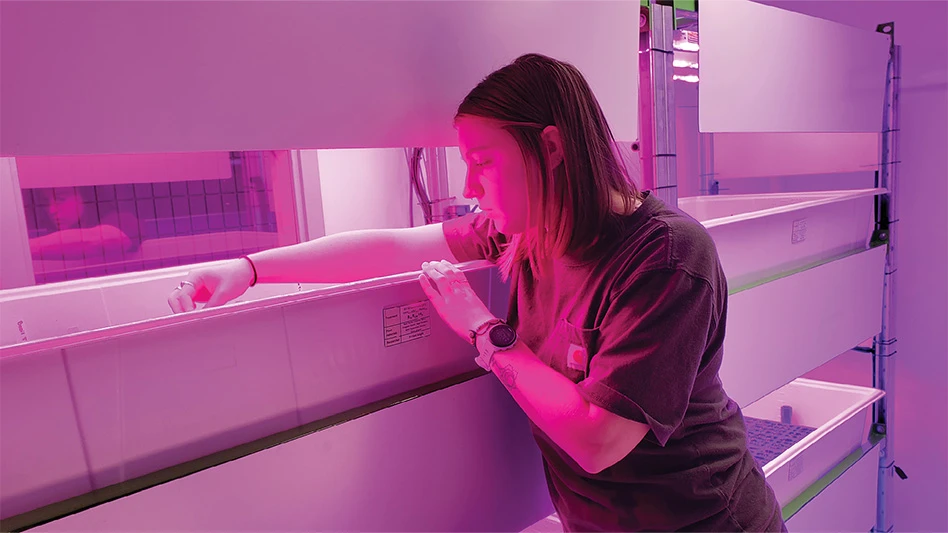 Shore flies can spread fungal plant diseases. Shore flies can spread fungal plant diseases. |
Fungus gnats and shore flies are two common pests in greenhouse and nursery operations. Damage caused by these insects can range from mild to severe and, in some cases, may result in partial or total crop loss. Proper pest identification is the first step in controlling these insects. Once a positive identification is made, control options including chemical, biological, cultural, physical, mechanical or a combination of several methods, provide growers with a multi-directional approach to controlling pest populations. In all situations, establish control programs early to target pest populations before they reach economic thresholds.
Identify pests
Based on visual observations, fungus gnats and shore flies are easily distinguished from one another. Correct identification is important because insecticides and biological control options with activity against one rarely have activity against the other.
 Keeping the floors of your greenhouses dry can help prevent pests. Make sure that between crops, you also disinfect benches and floors to prevent algae. Keeping the floors of your greenhouses dry can help prevent pests. Make sure that between crops, you also disinfect benches and floors to prevent algae. |
Adult fungus gnats are tiny (2.5 mm) black-grey flies with long legs and antennae. Wings have a Y-shaped vein near the edge that helps distinguish them from other long-legged flies, like other gnats, midges, crane flies or mosquitoes. Adults are weak fliers, often found close to the soil surface where they can deposit up to 300 eggs. Eggs typically hatch in three to six days and developing larvae (tiny, translucent, legless maggots with distinctive black heads) will feed on fungus or plant material. Adults do not feed directly on plant material; however, larvae can cause significant root damage, especially in propagation, and leave open wounds where pathogens can propagate. Larvae feed for approximately 14 days before pupating and becoming adults. Depending on temperature, fungus gnats will complete their life cycle in three to four weeks.
Adult shore flies are similar in size to fungus gnats, but are strong fliers that are stoutly built with short legs and antennae. Shore fly adults look similar to fruit flies, having black bodies, reddish eyes and dark wings with five distinctive light-colored spots on each wing. Females lay eggs anywhere algae is present such as growing medium, benches, floors, drains and walls. Larvae are yellowish-brown maggots with two forked, dark-tipped breathing tubes that feed on algae, bacteria, and other unicellular organisms. Development from an egg to an adult takes approximately three to four weeks, depending on temperature.
Unlike fungus gnat larvae, shore flies do not cause direct plant damage, but under extremely high populations, frass deposits on plant foliage can accumulate, decreasing the visual quality of the plant. Shore fly adults also can be a nuisance to growers and visitors when at high numbers.
Both shore flies and fungus gnats spread disease. When fungus gnat larvae feed on roots, they provide a potential entry point for fungal pathogens. Furthermore, both fungus gnats and shore flies can spread fungal plant diseases through excretion or by carrying spores on or in their bodies as the adults move from plant to plant.
| Get sticky Yellow sticky cards can be an important tool in monitoring your adult population of fungus gnats and shore flies.
|
Biological controls
The insect parasitic nematode, Steinernema feltiae, often is the first biological tool used for fungus gnat control. Insect parasitic nematodes (IPN) are microscopic, unsegmented, roundworms that are mass-produced and released in their infective juvenile stage to search out and enter insect pests. Once a nematode finds a suitable host, it enters through natural body openings. Once inside, nematodes release symbiotic bacteria that quickly kill hosts within 24 to 48 hours. S. feltiae is effective against fungus gnat larvae when applied regularly in a program. Nematodes can be applied as a soil drench by using commonly available spray equipment. You should use enough water to thoroughly soak the media, but not beyond the point where water overflows or leaches from pots. Because S. feltiae targets larvae, do not expect to see a decline in adult populations for seven to 10 days, unless using an adulticide.
Another effective biological control option is the soil-dwelling mite Hypoaspis. This less-than-1-mm, cream-colored mite is applied directly to the soil, where it will colonize and feed on an assortment of pests, including fungus gnat larvae and western flower thrips. Adult mites can kill up to seven fly larvae per day. Another good thing is this mite has a high tolerance to starvation. Newly emerged adults can survive for three to four weeks without food. If fed, adults can be active for four to five months. Hypoaspis also can be used under benches to target pests on the floor.
The predatory beetle Atheta coriaria (also known as the rove beetle) often is used in combination with Hypoaspis. This 3- 4-mm long beetle spends its life in the soil hunting for food. Highly mobile larvae and adults actively search for eggs, young larvae and pupae of fungus gnats and shore flies. Atheta also will attack western flower thrips when they drop to the soil to pupate — a life stage that traditional pesticides cannot control. Like Hypoaspis, Atheta can be used in pots and flats as well as on greenhouse floors.
It's important to remember that biological control agents, generally, are to be used preventively. For instance, Hypoaspis and Atheta will not effectively control existing high fly populations. Biological control agents need to be applied before economic thresholds are reached and preferably before pest populations are detected. Additionally, growers don't have to worry about resistance to biocontrol agents because it's hard for targeted pests to build resistance to being eaten.
| Simple steps to preventing pests Culturally, there are a few simple methods that can help prevent fungus gnats and shore fly.
Monitoring tip Want to monitor for fungus gnat larvae in your pots?
|
Insect parasitic nematodes also can be used for shore fly control. Steinernema carpocapsae, is the most effective IPN for shore fly control. Regular nematode applications are important to control shore fly populations. Spray nematodes to all areas of greenhouse that contain algae, including walls, benches, floors, drains and growing media. After the nematode application, keep surfaces moist for at least two hours. Use blackout curtains, close vents and switch off artificial lighting during this time. Use spray adjuvants to promote improved application uniformity and nematode movement. In addition to using S. carpocapsae, Hypoaspis and Atheta beetles can be used to help control shore fly populations. Be sure to treat all areas that could be harboring pest populations.
Pesticide programs
Some of the neonicotinoids also are registered for control of fungus gnat larvae. Examples that have been proven effective include Marathon, Flagship, Tristar and Safari. These products also are effective control agents of other pests like aphids and whitefly. Talstar is another product that can be used against larvae and adults, but note that Talstar has a two-month residual period and will kill most of the applied biological control agents. Applications of beneficial insects are not recommended within this time period. Insect parasitic nematodes are not harmed by Talstar, and can be used in combination. Horticultural oil, another viable alternative, can be used for suffocating adult fly populations and is considered softer on previously released beneficial insects.
If chemically controlling fungus gnats and shore flies, it's important to rotate the mode of action. Chemical resistance is an issue, and without rotation, several products may become ineffective for future pest generations. If you need help with rotating modes of action, check with your supplier or visit the chemical class chart from OHP at www.ohp.com/Literature/pdf/CCC_XIII.pdf.
Custom programs
Regardless of the control options used, it's important to develop a program that is tailored to a particular operation. A program that works well for one operation, may not work for others due to differences in pests species, pest population density, location, environmental conditions, etc. Each variable can change the outcome of the control measures. Know the strengths and weaknesses of control measures and figure out ways to properly and safely merge management systems. Know what life stages are targeted and keep detailed monitoring records. Make sure pesticides are rotated to prevent resistance issues. If possible, use biological and chemical programs together to preserve long-term effectiveness of pesticides. Do your homework when it comes to biological control agents. This can be a daunting task, so use others' expertise to educate yourself.

Julie Graesch is nematode field development specialist for Becker Underwood and can be reached at julie.graesch@beckerunderwood.com. Suzanne Wainwright-Evans is owner of Buglady Consulting and can be reached at www.BugladyConsulting.com.

Explore the January 2012 Issue
Check out more from this issue and find your next story to read.
Latest from Greenhouse Management
- USDA fires experts on invasive pests, including Asian citrus psyllid, chilli thrips
- CEA Alliance celebrates bipartisan introduction of Supporting Innovation in Agriculture Act
- Dümmen Orange North America celebrating 25th anniversary in 2025
- CEA HERB Part 1: Best management practices for culinary herbs
- Lawsuit challenges new H-2 visa rules
- CEA HERB Part 2: A guide to increasing the sowing density of culinary herbs
- Illinois Landscape Contractors Association changes name to Landscape Illinois
- 2025 Proven Winners Horticulture Scholarship applications now open








